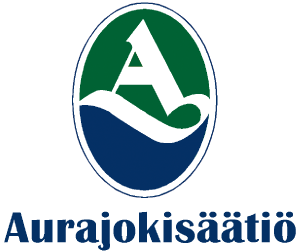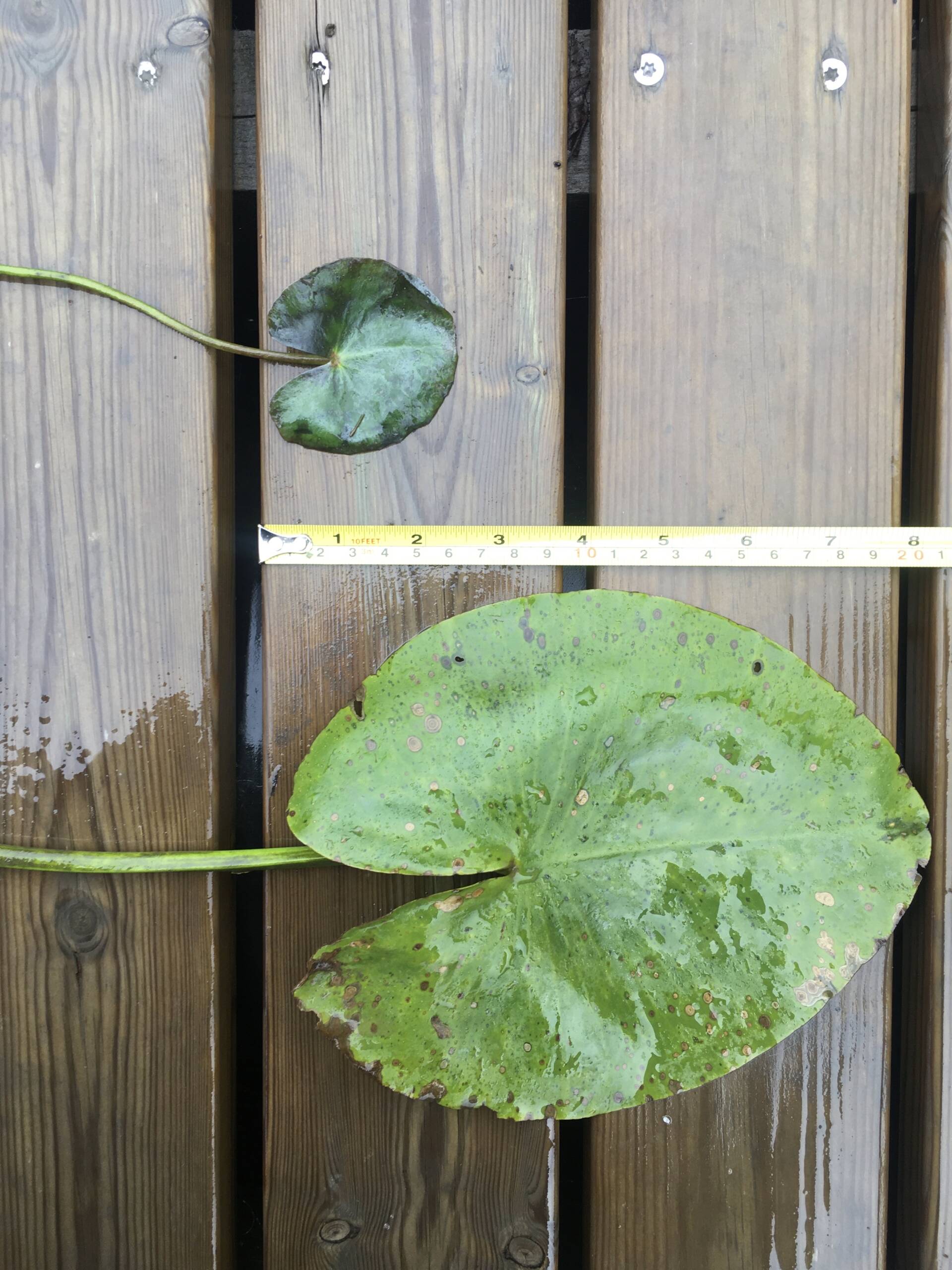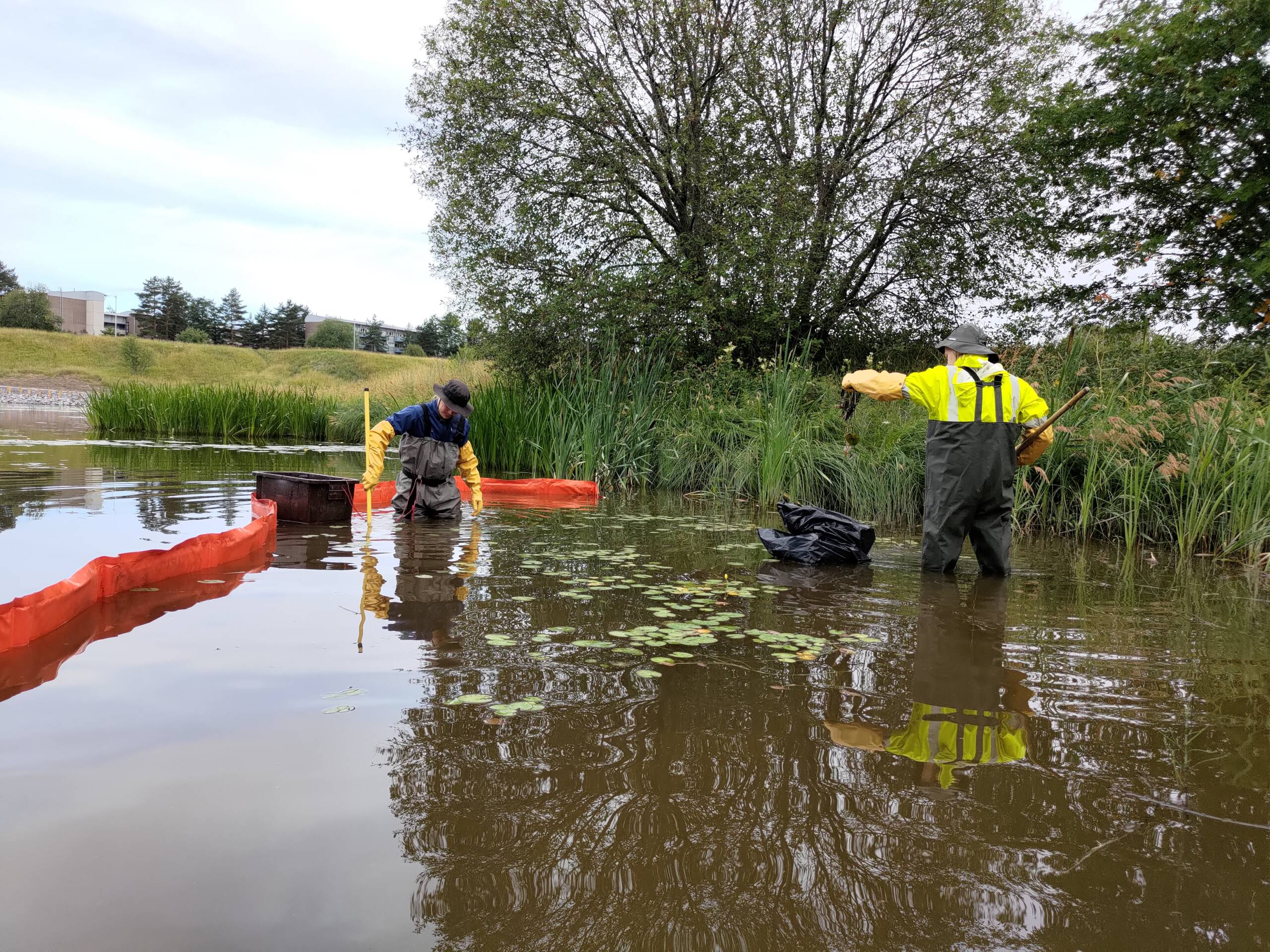Lammikki – An Unwanted Visitor in Aura River
Yellow floating heart (Nymphoides peltata) is a floating aquatic plant that does not naturally grow in Finland. Originally, it was brought here as an ornamental plant. In summer, the plant’s yellow, mat-like clusters of flowers may look beautiful, but it has proven to be an unwelcome guest. Its negative impacts on nature, water, fish, and recreational use are undeniable, and controlling it becomes increasingly difficult the more extensively it spreads. A more detailed species description can be found here.
In recent years, yellow floating heart has begun spreading rapidly in the Aura River. The first recorded finding of the plant in Finland was reportedly in Lake Littoistenjärvi in 2012. Since then, observations have been made in the Aura River, Naantali’s Luolalanjärvi, Raisio’s Haunisten reservoir, and most recently in the Paimionjoki River.
Identification
Yellow floating heart is often mistaken for the native yellow water-lily, but a closer look reveals clear differences. The flower is the same yellow color as that of the water-lily, but it is much smaller. In addition, the petals of yellow floating heart are hairy and fringed—reflected in its English name, “fringed lily.” The leaves are also noticeably smaller than those of the water-lily, typically 3–10 cm wide.
Other somewhat similar plants that yellow floating heart might be confused with include, based on leaf shape, frogbit and water shield. However, a flowering yellow floating heart is clearly distinguishable.
Impacts
The plant spreads both through stolons and seeds. Stolons can grow several meters within a few months, allowing the plant to take over large areas in a single summer while displacing native species. Decaying vegetation consumes oxygen, and the decomposing plant mass can cause oxygen depletion in winter. As waters become overgrown, recreational use of the river becomes more difficult, and the impacts may even affect the value of waterfront properties.
As a relatively new species in Finland — and currently occurring almost exclusively in Southwest Finland — yellow floating heart has not yet been added to the national list of harmful invasive species, which includes, for example, giant hogweed, rugosa rose, and Himalayan balsam, and for which a national invasive species strategy and management plans have been prepared. Nevertheless, the harmfulness of yellow floating heart is clear and widely recognized, and control efforts along the Aura River must begin before the plant’s spread becomes unmanageable.
Aurajokisäätiö’s control efforts
Aurajokisäätiö has been working since 2019 on a pilot project to control yellow floating heart in the Aura River. Surveying of this harmful plant began in 2018 when its accelerating spread was noticed.
Aurajokisäätiö has mapped yellow floating heart occurrences in the river since 2018. It appears that, contrary to the information on the vieraslaji.fi website, the species does not occur in the Savijoki tributary, but in the main channel of the Aura River it has begun spreading rapidly from Lieto toward Turku. The largest occurrences in Lieto are between Hakkistentie and Vanhalinna.
No occurrences were detected along the Vähäjoki branch in 2021, but surprisingly abundant stands were found in the northern part of the Maaria reservoir above Vähäjoki. Growth can also be clearly seen in aerial imagery commissioned by the municipality of Lieto in autumn 2020, as well as in Aurajokisäätiö’s 2021 aerial survey from Lieto to Turku, carried out in cooperation with Turun Elokuvaajat ry.
Aurajokisäätiö organized experimental hand-removal operations in the Aura River, with the largest efforts carried out at Vanhalinna in Lieto in 2019 and 2020, assisted by students from Livia vocational institute. On site, both boat-based and shore-based removal methods were tested. Vanhalinna supported the effort by lending boats to volunteers and taking responsibility for the collected plant waste. The waste was later destroyed on site through burning and composting — the most ecological methods for disposal — ensuring that no plant material returned to nature.
During the hot summer of 2021, yellow floating heart began spreading significantly along the main channel of the Aura River, and the bright yellow river bends attracted attention. Aurajokisäätiö complemented slow hand-removal with a trial of mechanical harvesting, in cooperation with the Västanfjärd-based company Östermalm Oy.
The base of operations was again Vanhalinna in Lieto, whose land was used for depositing plant waste. Technical expertise was provided by Kari Suonsilta/Aikari Oy. Fieldwork planning and implementation were carried out by Aurajokisäätiö’s invasive plant team: Suvi Hakulinen, Ville Autio, and Laura Karunen.
The pilot trials demonstrated that controlling yellow floating heart is extremely labor-intensive and long-term work, but not impossible. A positive finding was that growth removed late in the autumn did not regrow the following year nearly as quickly as growth removed in early summer of the same year. Aurajokisäätiö has continued hand removal during the 2022 and 2023 seasons. However, successful management requires continuous monitoring and a more efficient method to complement hand removal.
For inquiries about yellow floating heart control: Aurajokisäätiö info@aurajoki.net, tel. 040 5537 409.
Control methods
Important: If yellow floating heart is removed from a water body by cutting or hand-pulling, it is absolutely essential to ensure that loose plant fragments do not spread elsewhere. Careless removal can cause more harm than good.
Bird nesting must not be disturbed. Any nesting birds must be taken into account when planning removal in water bodies. More information can be found on BirdLife Finland’s website.
The following methods are currently known for non-chemical control of yellow floating heart:
1. Hand-pulling
Hand-pulling — removing the plant from the bottom with its roots — is a good way to eliminate smaller stands. The downside is that it is very labor-intensive. Removal is typically done standing in shallow water. Tools such as pitchforks and rakes can be used. Plants are gathered onto shore and taken far enough from the water that fragments or seeds cannot wash back into the river with rain. It is essential to ensure that any loose plant material does not drift to new locations. To prevent this, the removal area must be enclosed with a water barrier or net. Finally, the enclosed area is cleaned of remaining plant material using, for example, a fine-mesh dip net.
2. Cutting
Cutting in this context refers to cutting the plant’s stem below the water surface. Manual cutting can be done with a reed scythe while wading, or from a pier or boat. All plant waste must be collected. The waste is deposited in a suitable place as far from the shoreline as possible. Suitable tools for collecting include a rake, pitchfork, and a sturdy dip net. Waste can be gathered onto a tarpaulin and carried away from the shore. The cutting area must be enclosed with a water barrier to prevent the spread of plant fragments. Finally, the enclosed area is cleaned of plant debris using a fine-mesh dip net.
Cutting can also be performed mechanically on a larger scale. Special equipment designed for aquatic vegetation cutting can be used for this purpose. In mechanical cutting, it is extremely important to collect all plant waste from the water as thoroughly as possible. Mechanical cutting must always be reported to the ELY Centre.
3. Covering
Plants can be covered — blocking their access to light — either with a floating surface sheet or with a bottom-anchored sheet placed on the waterbed. Both methods effectively prevent plant growth. Eventually, the plants die and begin to decompose.
It is essential to ensure that the cover remains intact throughout the growing season. Covers must be securely anchored and clearly marked.
A bottom cover may be, for example, a rubber or plastic mat weighted down so that it stays on the bottom. The mat must not be completely airtight, because decomposing plant matter produces gases that accumulate under the cover. For this reason, the cover must have small holes or seams that allow gases to escape. The material must be highly resistant to UV radiation so it does not degrade into microplastics in the water.
Covers must be removed from the water in autumn. This prevents them from breaking apart and drifting into unintended areas. At the same time, the condition of the cover can be inspected.
Handling plant waste
Cutting or hand-pulling always generates plant waste that must be collected. It must never be left in the water, as fragments easily root and form new colonies.
Plant waste must be deposited far enough from the shoreline to prevent any risk of it washing back into the water.
Enclosing the cutting or pulling area with a water barrier is important. This ensures that floating plant fragments can be collected and the risk of spread minimized. More information on handling invasive plant waste can be found on the vieraskasvit.fi website.
With whose permission?
With the landowner’s permission, manual hand-pulling and manual cutting may be carried out without notifying authorities. In such cases, neighbors must be considered, and shareholders of the water area must be informed. Projects are often best carried out in cooperation with neighbors.
Mechanical aquatic vegetation cutting or dredging must be reported to the ELY Centre. (ELY Centre guidance)


